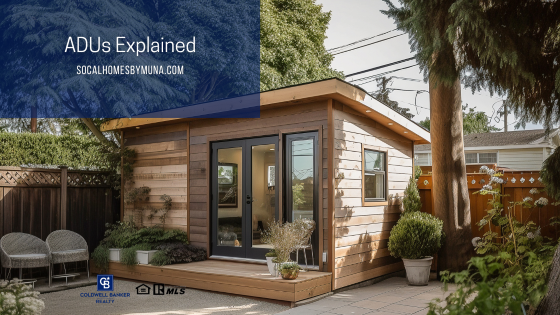The Lowdown on the Seller’s Disclosure

When buying a Southern California home, you deal with a lot of paperwork. But selling a home comes with paperwork, too. One very important form you need to fill out will be the Seller’s Disclosure form. This form is required as part of California Civil Code 1102 within seven days of an accepted purchase agreement. Sellers need to understand how this disclosure works and the importance of total transparency on this document in the sale process.
The Lowdown on the Seller’s Disclosure
What is a Seller’s Disclosure?
Also known as a property disclosure statement, a home disclosure, a real estate disclosure form, or (in California) the Transfer Disclosure Statement (or TDS), the seller’s disclosure is an important document in the home sale process. On this form, sellers provide answers to questions about the house’s condition, including current or former issues that the seller knows about. Typically these forms focus on roofing, basement and/or crawl spaces, plumbing, water/sewage, heating and cooling systems, drainage, electrical, HOA rules, and structural integrity.
What Does It Do?
This not only protects the buyer but also protects the seller. How? Well, let’s say that a few months after you sell your Southern California home, the buyer comes back and claims that they shelled out thousands of dollars for an issue they were never made aware of before they bought the home. If you disclosed it (as you should) before you sold it, this may protect you from paying for those issues. Also, in California, you must disclose whether your home resides in a natural hazard zone (subject to flash flooding, earthquakes, or wildfires). Even so, there is no way for sellers to know everything about a home, especially if the issues arose before they bought the home. And they are not legally held accountable for issues they were unaware of.
Honesty is Key
Real estate agents strongly encourage sellers to answer all questions with 100% honesty on the disclosure form. If you lie on the form, you may be held liable if a buyer proves you were aware of the problem and did not disclose it. That could cost you dearly. Also, half-truths could hurt you. For example, your pipes burst and caused a flood under your kitchen sink. From this flood, mold grew. You fixed the broken pipe, got rid of the mold, and replaced all of the drywall and cabinetry. Since it is no longer an issue, why worry the buyer by letting them know about it on the form? Well, if a leak happens again and the buyer learns from the plumber that there is evidence of it happening before, you might find yourself paying for their repairs…and then some. So, just answer the questions on the seller’s disclosure form as honestly as you can.
Muna Dionne, your Inland Empire specialist with Coldwell Banker Realty
Home Showings: Protecting Your Home and Yourself

It is inevitable. At some point during your home sale journey, strangers will step foot inside. Rarely do home buyers buy a property sight unseen. They want to see it. They want to touch it. Ultimately, they want to picture themselves living there. And you want that for them as well. But you worry about safety. And with the number of reported positive COVID cases on the rise in Riverside County recently, that may also include your health. When it comes to home showings, what steps should you take to protect your home and yourself?
Home Showings: Protecting Your Home and Yourself
Avoid Open Houses
First of all, some real estate agents like them. Others do not see any value in them. They may encourage a potential buyer to ask their own agent to set up a private showing. Ultimately, they bring many people into your home. More traffic may increase the possibility of someone stealing from you. After all, your agent cannot be everywhere at once. Talk to your REALTOR® about whether or not they believe an open house is necessary.
Clean Before, Clean After
Even with private home showings only, you still need to be cautious. Sanitize all surfaces, including door knobs, light switches, faucets, and countertops before a showing. Then go through the house and repeat these steps afterward.
Limit Contact
The fewer points of contact, the lower the chance of spreading germs. Open up all the blinds in your home. Make sure views out of your window remain unobstructed from window treatments. Turn on the light in every single room and closet. Leave all interior doors open.
Secure Your Valuables
This includes jewelry and watches as well as financial documents, passports, and other important paperwork. Take all prescriptions and other medicines out of the medicine cabinet in your bathrooms. Even regular mail may be enough for a sly criminal to grab for use later (like for identity theft). If you do not own a locking safe, you might want to put these all in a box and keep them in your car during the showing.
Nanny Cam Reporting for Duty!
Finally, make smart technology your friend. Install “nanny cams” inconspicuously throughout your home. Today’s cameras can easily be hidden on shelves and inside everyday items such as alarm clocks, smoke detectors, lamps, picture frames, and even electrical outlets (depending on how covert you wish to operate). Shop around to see what is available for your budget.
Muna Dionne, your Inland Empire specialist with Coldwell Banker Realty
Home Improvement Projects with the Best ROI

With the rising cost of just about everything, homeowners look to make smarter choices in improving their homes, especially if they plan on selling it soon. While installing a pool sounds like a great way to increase your home’s value, it actually offers one of the lowest ROIs of any project. Truth be told, most home improvement projects cost more than they actually receive in return. However, the following projects give you a 100+% return on your investment.
Home Improvement Projects with the Best ROI
#4 – New Entry Door
Coming in at #4 for ROI, experts suggest replacing your entry door with a new, stronger steel door. According to the 2023 Cost vs. Value Report conducted by Zonda Media, the average cost to install a brand new, quality steel door runs about $2214. But upon sale, homeowners can expect to receive $2235. That provides a 101% return on investment.
#3 – Update Siding
If your Southern California home actually has siding on it that looks worse for wear, you definitely need to replace it. But for the best ROI, replace that typical siding with manufactured stone veneer. The average cost of replacement runs about $10,925. However, it raises the value of your property when you sell it to $11,177. That is over 102% ROI.
#2 – Replace the Garage Door
This may come as a surprise to some, but it shouldn’t. After all, the garage door takes up a large portion of a home’s facade. The simple act of replacing this one thing creates a massive change in your home’s appearance as well as its curb appeal. In fact, this was one of the areas I suggest that homeowners focus on when they want to make any upgrades. On average, garage door replacement costs just over $4300. However, its value rises to $4418 when you sell your home. That means an almost 103% return on your investment.
#1 – Updating Your HVAC System to Electric
Home buyers continually look to decrease their carbon footprint and increase their home’s energy efficiency. Converting a natural gas-fueled HVAC system to an electrical one is becoming more and more in demand. But changing the HVAC to an electric heat pump comes at a cost. While #1 in ROI (at 103.5% on average), this also tends to be the most expensive. On average, it costs homeowners $17,747 to change over from fossil-fueled heating and air to an electric system. In turn, this increases your value to $18,366 during the sale of your home.
Some of these home improvement projects seem a little more budget-friendly than others. But they all recoup their costs and then some when you go to sell your Southern California home. So they are well worth the investment. When you are ready to put your property on the market, please make sure to contact me.
Muna Dionne, your Inland Empire specialist with Coldwell Banker Realty
ADUs Explained

Over the past few years, homeowners looked for extra ways to add living space to their properties without breaking the bank (and creating a huge remodel headache). Enter the Accessory Dwelling Unit. ADUs have seen a huge rise in popularity along the West Coast in recent years, especially in California.
Accessory Dwelling Units Explained
What are ADUs?
In-law quarters. She-shed. Studio. Guest house. An accessory dwelling unit is a completely separate housing unit from the main residence that sits on the same lot. These dwelling units range anywhere from a converted garage to residential space above the garage to a building independent from the main house.
Junior ADUs
These tend to run smaller than a traditional accessory dwelling unit. They must reside within the existing walls of the home. They cannot exceed 500 square feet of living space and must include an exterior door. Typically, this may be a bedroom converted into a mother-in-law suite with its own kitchenette and doorway outside.
California’s Rules and Regulations
Riverside County allows homeowners to add one accessory dwelling unit to their property. However, it cannot be placed in the front yard. Separate ADUs may house up to 1200 square feet of living space. However, attached units (such as a converted garage or space above the garage) cannot exceed 1200 square feet or more than half the main home’s living space (whichever number is smaller). Also, two-story units are allowed but cannot exceed 35 feet high.
ADUs require a permit to build. Homeowners must submit plans for their proposed unit as part of the permit application process. These units may be connected to current utilities on the property or they can have their own separate utility connection. This comes in handy if you plan on renting out the ADU.
Pros
Adding an accessory dwelling unit comes with quite a few positives. For example, they can create an extra income stream for homeowners. Unlike renting out a room in your house, a detached ADU provides an extra feeling of safety by allowing a renter to come and go without entering your residence. They also add value to your property. Finally, they increase your usable living space. For people who work from home, they provide a quiet place to perform their duties without distractions from others nearby.
Cons
On the flip side, they also come with some negatives. For example, they require a monetary investment. Plus, the additional space requires additional maintenance…which means additional monthly costs. If you rent out your unit, your renter knows exactly where to find you if there is a problem. And that could be at any time of the day or night. Also, they take up space in your yard that you will no longer be able to use for anything else. That’s a long-term commitment.
Before you build your own accessory dwelling unit, consider the pros and cons. Get quotes from several contractors. If you know your way around a hammer and nails, you might want to think about purchasing a kit. Make sure you do your due diligence with the City to find out permit requirements and costs as well. Good luck!
Muna Dionne, your Inland Empire specialist with Coldwell Banker Realty
How to Handle a Lowball Offer

Unfortunately, the days of expecting multiple offers above the list price sit firmly in the rearview mirror for most Inland Empire home sellers. Even so, it feels pretty exciting to get an offer for your property. However, that excitement may quickly change to dread when you realize that you just received a lowball offer. But before you turn that buyer down flat, find out the best way to handle this situation. You may still turn it into a sale you can be happy with after all.
How to Handle a Lowball Offer
Keep Your Emotions in Check
First of all, it’s understandable that you may feel insulted about the low offer price. After all, you put your blood, sweat, and tears into making this house a home. Nevertheless, you should not respond in anger or disgust. The buyer may have received bad advice or simply come from another area where submitting an extremely low offer on homes tends to be the norm.
Counter That Offer
Instead of getting angry, consider that lowball offer as more of a starting point for negotiations. Just because the offer came in much lower than you expected does not mean that you must accept it. Counter their offer with one of your own.
Counteroffer Options
Your REALTOR® should be able to help you draft a good counteroffer. Sometimes, dropping your price by 3-5% may be enough to make a deal happen. Other times, you might receive a counteroffer to your counteroffer. At that time, you might want to consider thinking about other things to sweeten the pot. For example, change the timeframe of escrow. Change it from 30 days to 45 days or vice versa depending on the buyer’s needs. Or accept their lower counteroffer but only if they agree to decrease the number of contingencies they put in place. Also, asking for a higher earnest money deposit or requiring a higher down payment helps insure that the buyer is serious about this sale as well. Talk over your options with your real estate agent first.
Muna Dionne, your Inland Empire specialist with Coldwell Banker Realty


 Facebook
Facebook
 X
X
 Pinterest
Pinterest
 Copy Link
Copy Link




